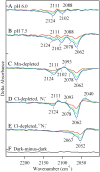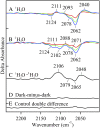Azide as a probe of proton transfer reactions in photosynthetic oxygen evolution
- PMID: 18805932
- PMCID: PMC2599857
- DOI: 10.1529/biophysj.108.136879
Azide as a probe of proton transfer reactions in photosynthetic oxygen evolution
Abstract
In oxygenic photosynthesis, photosystem II (PSII) is the multisubunit membrane protein responsible for the oxidation of water to O2 and the reduction of plastoquinone to plastoquinol. One electron charge separation in the PSII reaction center is coupled to sequential oxidation reactions at the oxygen-evolving complex (OEC), which is composed of four manganese ions and one calcium ion. The sequentially oxidized forms of the OEC are referred to as the S(n) states. S(1) is the dark-adapted state of the OEC. Flash-induced oxygen production oscillates with period four and occurs during the S(3) to S(0) transition. Chloride plays an important, but poorly understood role in photosynthetic water oxidation. Chloride removal is known to block manganese oxidation during the S(2) to S(3) transition. In this work, we have used azide as a probe of proton transfer reactions in PSII. PSII was sulfate-treated to deplete chloride and then treated with azide. Steady state oxygen evolution measurements demonstrate that azide inhibits oxygen evolution in a chloride-dependent manner and that azide is a mixed or noncompetitive inhibitor. This result is consistent with two azide binding sites, one at which azide competes with chloride and one at which azide and chloride do not compete. At pH 7.5, the K(i) for the competing site was estimated as 1 mM, and the K(i)' for the uncompetitive site was estimated as 8 mM. Vibrational spectroscopy was then used to monitor perturbations in the frequency and amplitude of the azide antisymmetric stretching band. These changes were induced by laser-induced charge separation in the PSII reaction center. The results suggest that azide is involved in proton transfer reactions, which occur before manganese oxidation, on the donor side of chloride-depleted PSII.
Figures




Similar articles
-
Perturbations at the chloride site during the photosynthetic oxygen-evolving cycle.Photosynth Res. 2007 Jun;92(3):345-56. doi: 10.1007/s11120-007-9147-3. Epub 2007 Mar 21. Photosynth Res. 2007. PMID: 17375370
-
Redox control and hydrogen bonding networks: proton-coupled electron transfer reactions and tyrosine Z in the photosynthetic oxygen-evolving complex.J Phys Chem B. 2013 Feb 7;117(5):1296-307. doi: 10.1021/jp3118314. Epub 2013 Jan 24. J Phys Chem B. 2013. PMID: 23346921
-
Calcium, Ammonia, Redox-Active Tyrosine YZ, and Proton-Coupled Electron Transfer in the Photosynthetic Oxygen-Evolving Complex.J Phys Chem B. 2017 Apr 27;121(16):3987-3996. doi: 10.1021/acs.jpcb.7b01802. Epub 2017 Apr 14. J Phys Chem B. 2017. PMID: 28409634
-
Fourier transform infrared difference and time-resolved infrared detection of the electron and proton transfer dynamics in photosynthetic water oxidation.Biochim Biophys Acta. 2015 Jan;1847(1):35-45. doi: 10.1016/j.bbabio.2014.06.009. Epub 2014 Jul 3. Biochim Biophys Acta. 2015. PMID: 24998309 Review.
-
Biological water oxidation.Acc Chem Res. 2013 Jul 16;46(7):1588-96. doi: 10.1021/ar3003249. Epub 2013 Mar 18. Acc Chem Res. 2013. PMID: 23506074 Review.
Cited by
-
A hydrogen-bonding network plays a catalytic role in photosynthetic oxygen evolution.Proc Natl Acad Sci U S A. 2012 Apr 17;109(16):6112-7. doi: 10.1073/pnas.1200093109. Epub 2012 Apr 2. Proc Natl Acad Sci U S A. 2012. PMID: 22474345 Free PMC article.
-
Detection of an intermediary, protonated water cluster in photosynthetic oxygen evolution.Proc Natl Acad Sci U S A. 2013 Jun 25;110(26):10634-9. doi: 10.1073/pnas.1306532110. Epub 2013 Jun 11. Proc Natl Acad Sci U S A. 2013. PMID: 23757501 Free PMC article.
-
Substitution of the D1-Asn87 site in photosystem II of cyanobacteria mimics the chloride-binding characteristics of spinach photosystem II.J Biol Chem. 2018 Feb 16;293(7):2487-2497. doi: 10.1074/jbc.M117.813170. Epub 2017 Dec 20. J Biol Chem. 2018. PMID: 29263091 Free PMC article.
-
Proton-coupled electron transfer.Chem Rev. 2007 Nov;107(11):5004-64. doi: 10.1021/cr0500030. Chem Rev. 2007. PMID: 17999556 Free PMC article. Review. No abstract available.
References
-
- Nelson, N., and C. F. Yocum. 2006. Structure and function of photosystems I and II. Annu. Rev. Plant Biol. 57:521–565. - PubMed
-
- Yocum, C. F. 2008. The calcium and chloride requirements of the O2 evolving complex. Coord. Chem. Rev. 252:296–305.
-
- Zouni, A., H.-T. Witt, J. Kern, P. Fromme, N. Krauß, W. Saenger, and P. Orth. 2001. Crystal structure of photosystem II from Synechococcus elongatus at 3.8 Å resolution. Nature. 409:739–743. - PubMed
-
- Biesiadka, J., B. Loll, J. Kern, K.-D. Irrgang, and A. Zouni. 2004. Crystal structure of cyanobacterial photosystem II at 3.2 Å resolution: a closer look at the Mn-cluster. Phys. Chem. Chem. Phys. 6:4733–4736.
Publication types
MeSH terms
Substances
LinkOut - more resources
Full Text Sources

